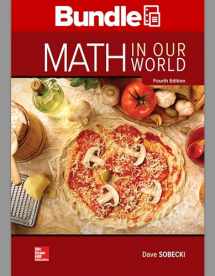
Loose Leaf for Math in Our World with Connect Math Hosted by ALEKS Access Card
Book details
Summary
Description
Mathematics in Our World, Fourth Edition Chapter 1: Problem Solving 1-1 The Nature of Mathematical Reasoning 1-2 Estimation and Interpreting Graphs 1-3 Problem Solving Strategies Chapter 1 Summary Chapter 2: Sets 2-1 Introduction to Set Theory 2-2 Subsets and Set Operations 2-3 Using Venn Diagrams to Study Set Operations 2-4 Using Sets to Solve Problems 2-5 Infinite Sets Chapter 2 Summary Chapter 3: Logic 3-1 Statements and Quantifiers 3-2 Truth Tables 3-3 Types of Statements 3-4 Logical Arguments 3-5 Euler Circles Chapter 3 Summary Chapter 4: Numeration Systems 4-1 Early and Modern Numeration Systems 4-2 Tools and Algorithms in Arithmetic 4-3 Base Number Systems 4-4 Operations in Base Number Systems Chapter 4 Summary Chapter 5: The Real Number System 5-1 The Natural Numbers 5-2 The Integers 5-3 The Rational Numbers 5-4 The Irrational Numbers 5-5 The Real Numbers 5-6 Exponents and Scientific Notation 5-7 Arithmetic and Geometric Sequences Chapter 5 Summary Chapter 6: Topics in Algebra 6-1 Applications of Linear Equations 6-2 Ratio, Proportion, and Variation 6-3 The Rectangular Coordinate System and Linear Equations in Two Variables 6-4 Functions 6-5 Quadratic, Exponential, and Logarithmic Functions Chapter 6 Summary Chapter 7: Consumer Mathematics 7-1 Percents 7-2 Personal Budgeting 7-3 Simple Interest 7-4 Compound Interest 7-5 Installment Buying 7-6 Student Loans and Home Buying 7-7 Investing in Stocks and Bonds Chapter 7 Summary Chapter 8: Measurement 8-1 Measures of Length: Converting Units and the Metric System 8-2 Measures of Area, Volume, and Capacity 8-3 Measures of Weight and Temperature Chapter 8 Summary Chapter 9: Geometry 9-1 Points, Lines, Planes and Angles 9-2 Triangles 9-3 Polygons and Perimeter 9-4 Areas of Polygons and Circles 9-5 Volume and Surface Area 9-6 Right Triangle Trigonometry 9-7 A Brief Survey of Non-Euclidean and Other Geometries Chapter 9 Summary Chapter 10: Probability and Counting Techniques 10-1 The Fundamental Counting Principle and Permutations 10-2 Combinations 10-3 Basic Concepts of Probability 10-4 Tree Diagrams, Tables, and Sample Spaces 10-5 Probability Using Permutations and Combinations 10-6 Odds and Expectation 10-7 The Addition Rules for Probability 10-8 The Multiplication Rules and Conditional Probability 10-9 The Binomial Distribution Chapter 10 Summary Chapter 11: Statistics 11-1 Gathering and Organizing Data 11-2 Picturing Data 11-3 Measures of Average 11-4 Measures of Variation 11-5 Measures of Position 11-6 The Normal Distribution 11-7 Applications of the Normal Distribution 11-8 Correlation and Regression Analysis Supplement: Misuses of Statistics Chapter 11 Summary Chapter 12: Voting Methods 12-1 Preference Tables and the Plurality Method 12-2 The Borda Count Method and the Plurality-with-Elimination Method 12-3 The Pairwise Comparison Method and Approval Voting 12-4 Apportionment 12-5 Apportionment Flaws Chapter 12 Summary Chapter 13: Graph Theory 13-1 Basic Concepts of Graph Theory 13-2 Euler''s Theorem 13-3 Hamilton Paths and Circuits 13-4 Trees Chapter 13 Summary Chapter 14-Available online: Other Mathematical Systems 14-1 Mathematical Systems and Groups 14-2 Clock Arithmetic 14-3 Modular Systems Chapter 14 Summary Appendix A: Area Under the Standard Normal Distribution Appendix B-Available Online: Using the TI-84 Plus Graphing Calculator Selected Answers Photo Credits Index


We would LOVE it if you could help us and other readers by reviewing the book
Book review



